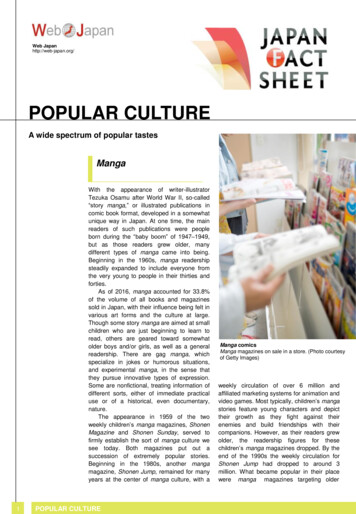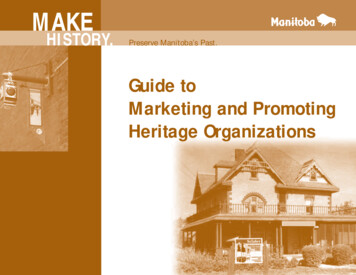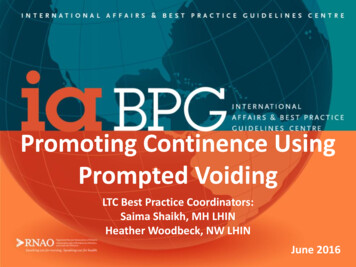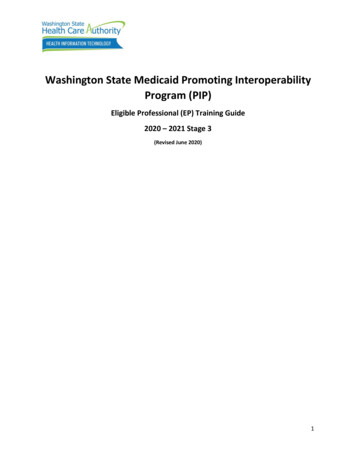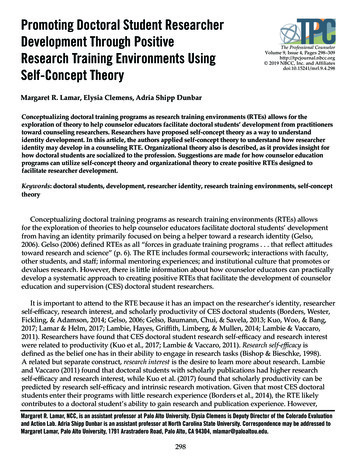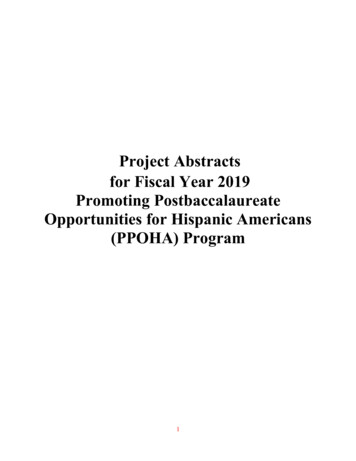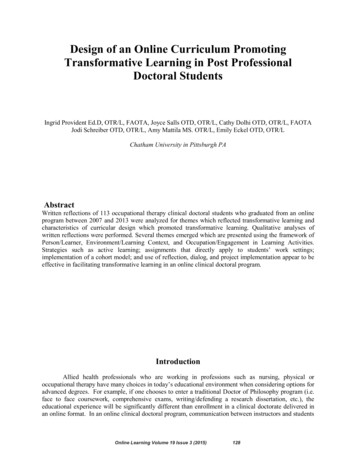
Transcription
Promoting a safety culture in maintenance
Safety is of paramount importance in high riskindustries, the concept of safety culture is ofgrowing importance in these industries as ameans of reducing the potential for large-scaledisasters, and accidents associated with routinetasks.Promoting a safety culture in maintenance
Hayward, (1997: 2) notes that: “Aircraft and otherindustrial mishaps are now investigated with a viewto comprehensively examine the systemic factorswhich may contribute to the occurrence and thecontext within which they occur.” Organisationaland human factors are recognised as the twoimportant factors in accident causation. This hasled to a recent focus on identifying the elementsthat best represent safety culture.Promoting a safety culture in maintenance
The aviation maintenance environmentAs the demand for global aviation increase, the airtraffic grows and this effectively places a demand onaircraft utilisation, resulting in increased timepressures on maintenance engineers for on-timeperformance. Consequently the quality ofmaintenance output suffers, creating a gap in thesafety system and an opportunity for human error(CAP 718, 2002: 1).Promoting a safety culture in maintenance
Definition of maintenance“collection of complex activities requiring aboveaverage coordination, communication andcooperation between inspectors, maintenancepersonnel, supervisors and other ground supportpersonnel.”Promoting a safety culture in maintenance
The CAP 718, 2002 document further highlights that,due to the increased global demand for commercialflights and constant financial pressures airlines areunder, fleet replacement are very rare. This results inmaintenance engineers having to maintain aircraft thatare increasing in age. The maintenance engineer is nowburdened with an older aircraft that require moreintensive inspection due to airframe fatigue and othercontributing deterioration aspects creating a stressfulwork environment. More concerning is that aircraftdeterioration is a subtle process that may go undetectedin the inspection process.Promoting a safety culture in maintenance
The fleet diversity, as well as the maintenance of olderand newer fleet requires maintenance engineers that arehighly skilled with a suitable educational background.Airlines thus have to ensure that their training is of a highstandard.The local maintenance environment must also beconsidered. Lack of space, inadequate safety conditionsor inefficient shift change procedures are majorcontributors to the non completion of tasks. Taskcompletion may run up against cross-organisationalconflict including incompatibility of other proceduresand terminology.Promoting a safety culture in maintenance
The aircraft maintenance engineerPromoting a safety culture in maintenance
Today, aircraft maintenance engineers must be highlyknowledgeable in terms of aircraft mechanical systems,avionics and aircraft structural components, be able tomaintain a diverse selection of aircraft, perform complextasks and interpret results of tests performed, andevaluate and maintain sensitive and automated systems.One misinterpretation could be fatal, not to the engineerbut to passengers and flight crew. Trends in aircraftdevelopment are an indication of the skills required byaircraft technicians.Promoting a safety culture in maintenance
To promote a safety culture in maintenance wehave to focus on two very important categories.Organisational and Human factorsPromoting a safety culture in maintenance
OrganizationalReporting methods and structuresSMSASQSPromoting a safety culture in maintenance
Human factorsPromoting a safety culture in maintenance
In a high-technology industry like aviationthe focus of problem solving is often ontechnology. However, the accident recordrepeatedly demonstrates that at least three out offour accidents involve performance errors made byapparently healthy and appropriately qualifiedindividuals. In the rush to embrace newtechnologies, the fallible mortals who mustinterface with and use this equipment are oftenoverlooked. The human element is the mostflexible and adaptable part of the aviation system,but it is also the most vulnerable to influences thatcan adversely affect its performance.Promoting a safety culture in maintenance
The cost of maintenance errorIt has been said that an airline is only as good asits safety record. If its safety record is in jeopardy,the airline will have little chance of surviving. Therole of humans is the key to the safetymanagement system. The ICAO 2003 documentsuggests that airlines have a choice of threeapproaches to human-factor interventions:Promoting a safety culture in maintenance
1. “Do nothing” approach: No initiatives aretaken to counteract human-factor issues aproblems are only addressed when it arises2. “Reactive” approach: Consideration ofhuman-factor issues is left to very late in thedevelopment process3. “Proactive” approach: Human-factor issuesare fixed before they become problems.Promoting a safety culture in maintenance
The nature of human error in maintenanceoccurrencesRecent studies have shown that human error inmaintenance is on the increase; however thisphenomenon has been somewhat overlooked. In one ofthe first examinations of the problem, the UK CivilAviation Authority produced a list of the most frequentmaintenance errors in aircraft over 5 700 kg.Promoting a safety culture in maintenance
The top eight problems were as follows:1. Incorrect installation of components2. The fitting of wrong parts3. Electrical wiring discrepancies (including crossconnections)4. Loose objects (e.g. tools) left in the aircraft5. Inadequate lubrication6. Cowlings, access panels and fairings not secured7. Fuel/oil caps and refuel panels not secured8. Landing gear ground lock pins not removedbefore departure” (ATSB, 2001).Promoting a safety culture in maintenance
Even if not entirely preventable, human errors arecontrollable through the implementation ofenhanced technology, suitable regulations andprocedures and appropriate training courses.Methods used to minimise human error isgenerally targeted at line managers orsupervisors.Promoting a safety culture in maintenance
Line managers or Supervisors.Proper training to identify human factorsOrganisational support to correct suchfactorsPromoting a safety culture in maintenance
The performance of technical staff including; pilots,air traffic controllers and maintenance persons issusceptible to factors influencing the workplace,including; regulatory, sociocultural, environmentaland organisational factors (ICAO 2005:3-19).Promoting a safety culture in maintenance
Three strategies for managing human errorPromoting a safety culture in maintenance
The first strategy is error reduction, which seeksto directly intervene at the source of the error byreducing or eliminating any adverse conditionsthat would increase the risk of error. Examples oferror reduction include the improved maintenance facilities and ease of access or toolsrequired to perform tasks.Promoting a safety culture in maintenance
The second strategy of error capture ananticipating strategy which assumes the error hasalready been made. Error capture is distinguishedfrom error reduction in that capture does not serveto directly eliminate the error from initialoccurring, but rather to mitigate its effects.Examples of error capture strategies include crosschecking to verify correct task completion and testflights include improving access to aircraftcomponents for maintenance.Promoting a safety culture in maintenance
The third strategy of error tolerance refers tothe ability of a system to accept an error withoutresulting in serious consequence. Examples ofthis include the incorporation of redundancysystems, for example aircrafts have multipleelectrical systems or in the case of maintenancemultiple structural inspection to detectweaknesses in the fuselage.Promoting a safety culture in maintenance
The concept of cultureAviation safety goes beyond geographic boundaries or culture.The aviation industry has managed to standardise the industryaccording to aircraft types, nationalities and countries.However, identifying that people react differently to similarsituations is not difficult.Interaction within the industry is affected by culturaldifferences and differences in backgrounds. Culture affects howindividuals deal with various situations.Companies are affected by cultural influences at all levels of theorganisation. According toICAO (2005: 3 – 14), the subsequent levels of culture (nationalculture, professional culture and organisational culture) areapplicable to accident prevention programmes:Promoting a safety culture in maintenance
National culture differentiates the general characteristicsand values of a certain nation as a whole. As an example onecan look at the way different nationalities responds toauthority, how people deal with uncertainty and howindividual express themselves. Not all cultures focus on thecollective welfare of the group, team or organisation.Inequality in terms of status and a high level of respect givento leaders is an accepted norm in collectivist cultures.These factors may however inhibit individual’s willingness toquestion decisions made by superiors. This is an importantfactor influencing Maintenance Resource Management(MRM) as the mixing of national cultures could affect outputand team performance due to misunderstanding.Promoting a safety culture in maintenance
Developing a safety cultureAn effective tool for improving a safety cultureis to develop and maintain a positive safetyculture. The challenge is how to develop aculture that is favourable to good safetyperformance.Promoting a safety culture in maintenance
Changing attitudes and behaviours:Safe behaviours can be enhanced by capitalisingon activities such as short talks, hazard signsand training. However, if things arecommunicated in the way that the work is easier,and the task can be finished earlier and thusrewarded with monetary incentive, employeeswill cut corners, may not observe safety rules,neglect to wear personal protective equipment,and ultimately not work safely.Promoting a safety culture in maintenance
Management commitment:Management plays a key role in promoting apositivesafetyculture.Management’scommitment can be demonstrated by efficientresource allocation, time management, walkthe-talk, inspections and by encouragingemployees to contribute to committee meetings.Promoting a safety culture in maintenance
Employee involvement:For a positive safety culture, employees’involvement, ownership and commitment isnecessary; in particular, empowerment creates asense of self-worth, belonging and value.Employees should be involved in training,consulted about noise, machinery isolation,sound barriers, job rotation and wearing orpurchasing of safety equipment.Promoting a safety culture in maintenance
Promotional strategies:Promotional strategies to be used should includethe following:1. Posters of the mission statement and safetyslogans so that all employees have access toread them.2. Publishing safety statistics the airline’s safetystatistics and safety promotional items on asafety notice board.Promoting a safety culture in maintenance
Training and seminars:Training activities should include short talks, groupmeetings, training for personal fitness, hygiene, workplacestress and responsibilities towards safety (includingcompliance with rules and regulations, hazardidentification and risk assessment, incident investigationand job safety analysis).Promoting management commitment and employeeparticipation in safety can enhance the organisation’ssafety culture.When employees become more aware of theirresponsibilities for incident and injury prevention, theywill exhibit more interest in maintaining a safe andhealthy work site.Promoting a safety culture in maintenance
1. Management commitment to safety2. Management concern for the workforce3. Mutual trust and credibility betweenmanagement and the employees4. Line managers and supervisors advancehuman factor training5. Workforce empowerment6. Continuous monitoring, corrective action,review of systems and continuous improvementto reflect the safety at the work site.Promoting a safety culture in maintenance
The goal is to add value andsafety to all maintenancewhile reducing the stressfactorThank youPromoting a safety culture in maintenance
1. Posters of the mission statement and safety slogans so that all employees have access to read them. 2. Publishing safety statistics the airline’s safety statistics and safety promotional items on a safety notice board. Promoting a safety culture in maintenance


